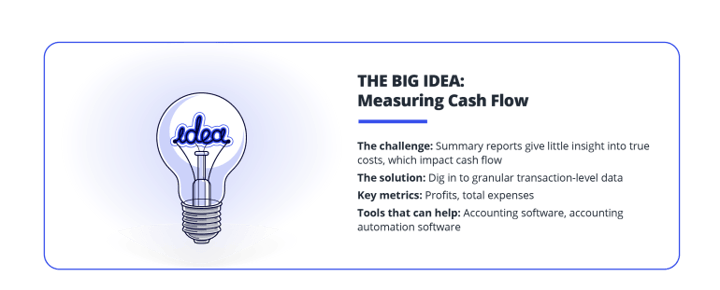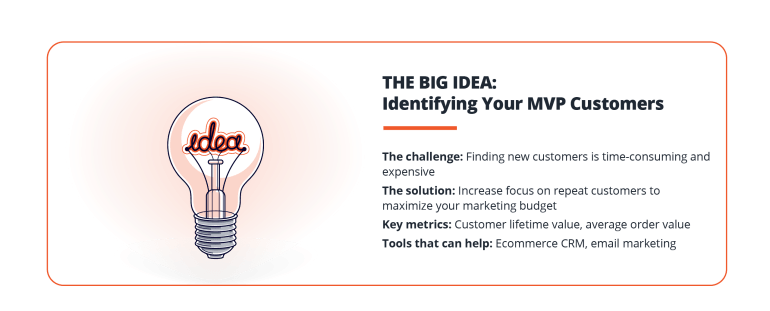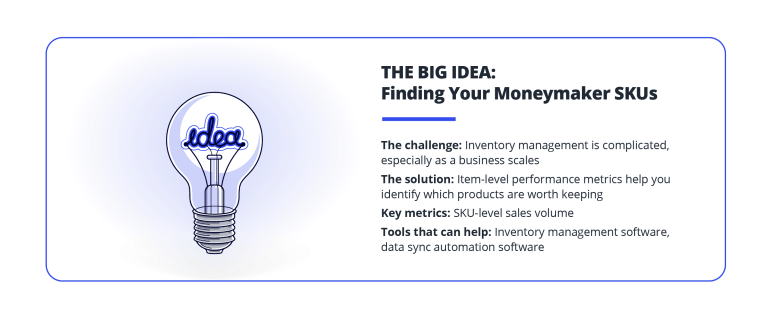
3 Insights That Will Light Up Your Ecommerce Growth
Contents
In the wake of unprecedented global events — including massive shifts in both the economy and consumer behavior — the ecommerce industry is experiencing a veritable rollercoaster ride when it comes to growth. The good news for small sellers? Everyone’s dealing with marketplace turbulence, so you’re not alone. But if you want to weather these changes and get a leg up on the competition, you’ll need to start planning ahead. And that means digging into your data.
A good grasp of your core business metrics will help you move into each quarter with confidence, a measure of predictability, and a solid strategic plan. And while there’s endless data to track depending on your goals, three key ecommerce insights are critical to every online retailer. Read on for tips on how to keep an eye on business cash flow, SKU performance, and customer behavior, so you can ease the ups and downs of your small ecommerce business and enjoy the journey instead.
Measure Cash Flow to Project Growth
- The challenge: Summary reports give little insight into true costs, which impact cash flow
- The solution: Dig in to granular transaction-level data
- Key metrics: Profits, total expenses
- Tools that can help: Accounting software, accounting automation software
It’s easy to get excited about every sale during the early stages of your ecommerce business, but revenue is far from the only important financial metric. Among other things, sellers need to track cash flow to understand their business longevity and growth potential.
To start, knowing your business’ total revenue per time period is essential. Savvy sellers leverage this data to track how their customers are spending money, target areas for expansion, and move resources around accordingly. Once you’re able to project your company’s incoming revenue—along with the overhead costs of the business—you can use your projections to maximize your profit and strengthen your business prospects. This data will also help you determine if your business can remain sustainable for the long term. Be sure to note if/how your cash flow changes through regular intervals to plan ahead more accurately.

Accounting platforms like QuickBooks are great places for smaller sellers to begin tracking cash flow because they provide intuitive, dependable reports that highlight financial performance. However, for online sellers, there’s an added challenge: Many ecommerce platforms and marketplaces only provide summary financial reporting, when it’s actually critical to gain insight into your transaction-level data to get a full picture of how well your business is operating. Doing so allows you to see your true expenses and explore exactly where they’re coming from, so you can potentially make adjustments to scale profitability.
Identify MVP Customers for Laser-Focused Marketing
- The challenge: Finding new customers is time-consuming and expensive
- The solution: Increase focus on repeat customers to maximize your marketing budget
- Key metrics: Customer lifetime value, average order value
- Tools that can help: Ecommerce CRM, email marketing software, retargeting software
With seemingly endless options for where to shop, consumers have their pick of how to spend money. An overly saturated online retail market also means sellers are in a constant bidding war to win over prospective customers, and marketing campaigns can get expensive quickly. Why not focus instead on the customers you already have? Inspiring loyalty in your customers will go a long way toward retaining your existing pool, and it’s far easier and more cost-effective than trying to constantly acquire new ones. Additionally, personalizing how you reach out to customers makes them feel like their choice of retailer really sees and understands what they’re looking for—which will convince them to remain a loyal customer.
Laser-focused ecommerce customer marketing includes email personalization, targeted ads on platforms like Instagram and Facebook, and utilizing artificial intelligence tools to recommend specific products or services on your website. Email personalization in particular is easier and more effective than ever. Software programs like Constant Contact allow you to tailor how you reach out to each individual customer, then offer special deals and recommendations depending on their history with your business.

Another effective strategy for customer retention is establishing a convenient and streamlined user experience from start to finish. If your website is clear and easy to navigate with a simplified checkout process, customers are more likely to come back — and they might even bring friends. Taking the time to build relationships with your customers makes them feel appreciated by their choice of online retailer, which increases the chances that they’ll return again and again.
Take Stock to Find Moneymaker SKUs
- The challenge: Inventory management is complicated, especially as a business scales
- The solution: Item-level performance metrics help you identify which products are worth keeping
- Key metrics: SKU-level sales volume
- Tools that can help: Inventory management software, data sync automation software
So your business is up and running and you have a customer-marketing strategy in place—what now? It’s time to rev up your inventory management by identifying the performance of every SKU you sell. Once again, this is difficult to do without granular data, which many ecommerce marketplaces and shopping carts fail to provide. The answer? Automating the data sync between your online store(s) and accounting platform. Doing so allows you to see the details of every sale and then determine which products are selling the best, which ones to cut, and how you can approach growing your catalog.

Cutting any low-profit items will allow you to target more popular products or services, and as a result increase your cash flow going forward. You can also review products that may not fit in as well with your catalog and remove them accordingly to better streamline your offerings. Finding a niche within your chosen industry will create a stronger product, inspire more customer loyalty, and help strengthen your brand profile.
Make This Year Your Strongest Yet
Savvy sellers know that leveraging all of the insights — and tools — at their disposal is crucial to scaling ecommerce businesses into sustainable and profitable ventures. Keeping a close eye on cash flow, identifying best sellers, and nurturing top customers are key initiatives every online retailer can put into play when using data to their advantage. Then even during the bumpiest year, your bottom line will thank you.
By guest contributor Taylor Knauf



 The Webgility Team
The Webgility Team


